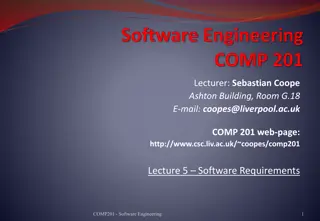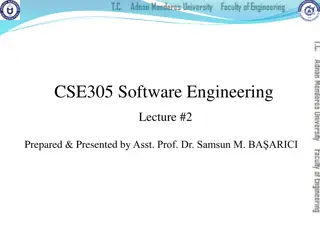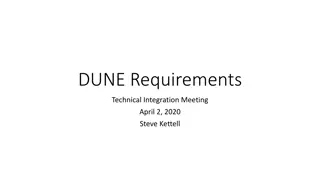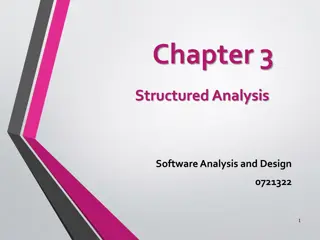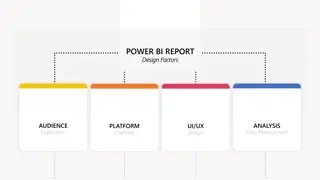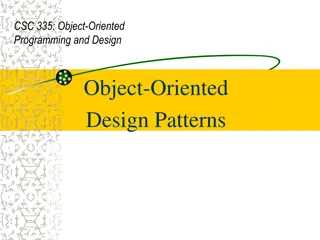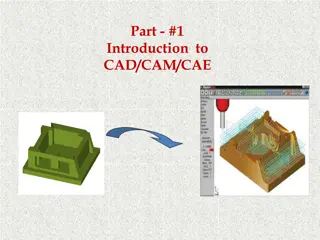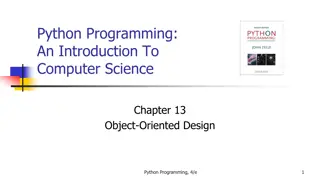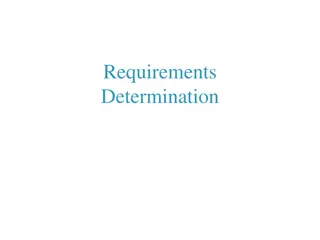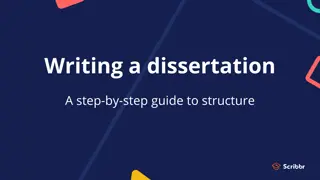Structuring Systems Process Requirements in Systems Analysis & Design
Understand the logical modeling of processes through data flow diagrams, decompose diagrams, balance levels, and discuss process modeling for electronic commerce applications. Learn to graphically represent processes, capture data flows, and create deliverables for current and new systems.
Download Presentation

Please find below an Image/Link to download the presentation.
The content on the website is provided AS IS for your information and personal use only. It may not be sold, licensed, or shared on other websites without obtaining consent from the author. Download presentation by click this link. If you encounter any issues during the download, it is possible that the publisher has removed the file from their server.
E N D
Presentation Transcript
CSE 414 Systems Analysis and Design Lecture #6 Structuring Systems Process Requirements Prepared & Presented byAsst. Prof. Dr. Samsun M. BA ARICI
Learning Objectives Understand the logical modeling of processes by studying examples of data flow diagrams (DFDs). Draw data flow diagrams following specific rules and guidelines that lead to accurate and well-structured process models. Decompose data flow diagrams into lower-level diagrams. Balance higher-level and lower-level data flow diagrams. Lecture #6 Structuring Systems Process Requirements 2
Learning Objectives (Cont.) Use data flow diagrams as a tool to support the analysis of information systems. Discuss process modeling for electronic commerce applications. Use decision tables to represent the logic of choice in conditional statements. Lecture #6 Structuring Systems Process Requirements 3
Process Modeling for Structured Analysis FIGURE 7-1 Systems development life cycle with the analysis phase highlighted Lecture #6 Structuring Systems Process Requirements 4
Process Modeling (Cont.) Graphically represent the processes that capture, manipulate, store, and distribute data between a system and its environment and among system components. Utilize information gathered during requirements determination. Model processes and data structures. Lecture #6 Structuring Systems Process Requirements 5
Deliverables and Outcomes Context data flow diagram (DFD) Scope of system DFDs of current physical system Adequate detail only DFDs of current logical system Enables analysts to understand current system Lecture #6 Structuring Systems Process Requirements 6
Deliverables and Outcomes (Cont.) DFDs of new logical system Technology independent Show data flows, structure, and functional requirements of new system Thorough description of each DFD component Lecture #6 Structuring Systems Process Requirements 7
Data Flow Diagramming Mechanics Represent both physical and logical information systems Only four symbols are used Useful for depicting purely logical information flows DFDs that detail physical systems differ from system flowcharts which depict details of physical computing equipment. Lecture #6 Structuring Systems Process Requirements 8
Definitions and Symbols FIGURE 7-2 Comparison of DeMarco and Yourdon and Gane and Sarson DFD symbol sets Lecture #6 Structuring Systems Process Requirements 9
Definitions and Symbols (Cont.) Process: work or actions performed on data (inside the system) Data store: data at rest (inside the system) Source/sink: external entity that is the origin or destination of data (outside the system) Data flow: arrows depicting movement of data Lecture #6 Structuring Systems Process Requirements 10
Developing DFDs Context diagram is an overview of an organizational system that shows: the system boundaries. external entities that interact with the system. major information flows between the entities and the system. Note: only one process symbol, and no data stores shown Lecture #6 Structuring Systems Process Requirements 11
Context Diagram FIGURE 7-4 Context diagram of Hoosier Burger s food-ordering system Lecture #6 Structuring Systems Process Requirements 12
Developing DFDs (Cont.) Level-0 diagram is a data flow diagram that represents a system s major processes, data flows, and data stores at a high level of detail. Processes are labeled 1.0, 2.0, etc. These will be decomposed into more primitive (lower-level) DFDs. Lecture #6 Structuring Systems Process Requirements 13
Level-0 Diagram FIGURE 7-5 Level-0 DFD of Hoosier Burger s food-ordering system Lecture #6 Structuring Systems Process Requirements 14
Data Flow Diagramming Rules There are two DFD guidelines that apply: The inputs to a process are different from the outputs of that process. Processes purpose is to transform inputs into outputs. Objects on a DFD have unique names. Every process has a unique name. Lecture #6 Structuring Systems Process Requirements 15
Data Flow Diagramming Rules (Cont.) TABLE 7-2 Rules Governing Data Flow Diagramming Lecture #6 Structuring Systems Process Requirements 16
Data Flow Diagramming Rules (Cont.) TABLE 7-2 Rules Governing Data Flow Diagramming (cont.) Lecture #6 Structuring Systems Process Requirements 17
Data Flow Diagramming Rules (Cont.) Figure 7-6 Incorrect and correct ways to draw DFDs Lecture #6 Structuring Systems Process Requirements 18
Decomposition of DFDs Functional decomposition is an iterative process of breaking a system description down into finer and finer detail. Creates a set of charts in which one process on a given chart is explained in greater detail on another chart. Continues until no subprocess can logically be broken down any further. Lecture #6 Structuring Systems Process Requirements 19
Decomposition of DFDs (Cont.) Level-1 diagram results from decomposition of Level-0 diagram. Level-n diagram is a DFD diagram that is the result of n nested decompositions from a process on a level-0 diagram. Primitive DFD is the lowest level of a DFD. Lecture #6 Structuring Systems Process Requirements 20
Level-1 DFD FIGURE 7-8 Level-1 diagram showing the decomposition of Process 4.0 from the level-0 diagram for Hoosier Burger s food-ordering system Level-1 DFD shows the sub-processes of one of the processes in the Level-0 DFD. Processes are labeled 4.1, 4.2, etc. These can be further decomposed in more primitive (lower-level) DFDs if necessary. This is a Level-1 DFD for Process 4.0. Lecture #6 Structuring Systems Process Requirements 21
Level-n DFD FIGURE 7-9 Level-2 diagram showing the decomposition of Process 4.3 from the level-1 diagram for Process 4.0 for Hoosier Burger s food-ordering system Level-n DFD shows the sub-processes of one of the processes in the Level n-1 DFD. This is a Level-2 DFD for Process 4.3. Processes are labeled 4.3.1, 4.3.2, etc. If this is the lowest level of the hierarchy, it is called a primitive DFD. Lecture #6 Structuring Systems Process Requirements 22
Balancing DFDs Conservation Principle: conserve inputs and outputs to a process at the next level of decomposition Balancing: conservation of inputs and outputs to a data flow diagram process when that process is decomposed to a lower level Lecture #6 Structuring Systems Process Requirements 23
Balancing DFDs (Cont.) Balanced means: Number of inputs to lower level DFD equals number of inputs to associated process of higher-level DFD Number of outputs to lower level DFD equals number of outputs to associated process of higher-level DFD Lecture #6 Structuring Systems Process Requirements 24
Balancing DFDs (Cont.) FIGURE 7-10 An unbalanced set of data flow diagrams (a) Context diagram 1 input 1 output This is unbalanced because the process of the context diagram has only one input but the Level-0 diagram has two inputs. (b) Level-0 diagram 2 inputs 1 output Lecture #6 Structuring Systems Process Requirements 25
Balancing DFDs (Cont.) Data flow splitting is when a composite data flow at a higher level is split and different parts go to different processes in the lower level DFD. The DFD remains balanced because the same data is involved, but split into two parts. Lecture #6 Structuring Systems Process Requirements 26
Balancing DFDs (Cont.) FIGURE 7-11 Example of data flow splitting (a) Composite data flow (b) Disaggregated data flows Lecture #6 Structuring Systems Process Requirements 27
Balancing DFDs: More DFD Rules Lecture #6 Structuring Systems Process Requirements 28
Four Different Types of DFDs Current Physical Process labels identify technology (people or systems) used to process the data. Data flows and data stores identify actual name of the physical media. Current Logical Physical aspects of system are removed as much as possible. Current system is reduced to data and processes that transform them. Lecture #6 Structuring Systems Process Requirements 29
Four Different Types of DFDs (Cont.) New Logical Includes additional functions Obsolete functions are removed. Inefficient data flows are reorganized. New Physical Represents the physical implementation of the new system Lecture #6 Structuring Systems Process Requirements 30
Guidelines for Drawing DFDs Completeness DFD must include all components necessary for system. Each component must be fully described in the project dictionary or CASE repository. Consistency The extent to which information contained on one level of a set of nested DFDs is also included on other levels Lecture #6 Structuring Systems Process Requirements 31
Guidelines for Drawing DFDs (Cont.) Timing Time is not represented well on DFDs. Best to draw DFDs as if the system has never started and will never stop. Iterative Development Analyst should expect to redraw diagram several times before reaching the closest approximation to the system being modeled. Lecture #6 Structuring Systems Process Requirements 32
Guidelines for Drawing DFDs (Cont.) Primitive DFDs Lowest logical level of decomposition Decision has to be made when to stop decomposition Lecture #6 Structuring Systems Process Requirements 33
Guidelines for Drawing DFDs (Cont.) Rules for stopping decomposition When each process has been reduced to a single decision, calculation or database operation When each data store represents data about a single entity Lecture #6 Structuring Systems Process Requirements 34
Guidelines for Drawing DFDs (Cont.) Rules for stopping decomposition, cont. When the system user does not care to see any more detail When every data flow does not need to be split further to show that data are handled in various ways Lecture #6 Structuring Systems Process Requirements 35
Guidelines for Drawing DFDs (Cont.) Rules for stopping decomposition, cont. When you believe that you have shown each business form or transaction, online display and report as a single data flow When you believe that there is a separate process for each choice on all lowest-level menu options Lecture #6 Structuring Systems Process Requirements 36
Using DFDs as Analysis Tools Gap Analysis is the process of discovering discrepancies between two or more sets of data flow diagrams or discrepancies within a single DFD. Inefficiencies in a system can often be identified through DFDs. Lecture #6 Structuring Systems Process Requirements 37
Using DFDs in BPR FIGURE 7-16 IBM Credit Corporation s primary work process before BPR (Source: Based on Hammer and Champy, 1993.) Lecture #6 Structuring Systems Process Requirements 38
Using DFDs in BPR (Cont.) FIGURE 7-17 IBM Credit Corporation s primary work process after BPR (Source: Based on Hammer and Champy, 1993.) Lecture #6 Structuring Systems Process Requirements 39
Modeling Logic with Decision Tables Decision table: a matrix representation of the logic of a decision which specifies the possible conditions for the decision and the resulting actions Best used for complicated decision logic Lecture #6 Structuring Systems Process Requirements 40
Modeling Logic with Decision Tables (Cont.) Condition stubs: that part of a decision table that lists the conditions relevant to the decision Action stubs: that part of a decision table that lists the actions that result for a given set of conditions Rules: that part of a decision table that specifies which actions are to be followed for a given set of conditions Indifferent condition: in a decision table, a condition whose value does not affect which actions are taken for two or more rules Lecture #6 Structuring Systems Process Requirements 41
Modeling Logic with Decision Tables (Cont.) FIGURE 7-18 Complete decision table for payroll system example Lecture #6 Structuring Systems Process Requirements 42
Modeling Logic with Decision Tables (Cont.) Procedure for Creating Decision Tables Name the condition and the values that each condition can assume. Name all possible actions that can occur. List all possible rules. Define the actions for each rule. Simplify the table. Lecture #6 Structuring Systems Process Requirements 43
Modeling Logic with Decision Tables (Cont.) FIGURE 7-19 Reduced decision table for payroll system example Lecture #6 Structuring Systems Process Requirements 44
Electronic Commerce Application: Process Modeling using Data Flow Diagrams Process modeling for Pine Valley Furniture s WebStore Completed JAD session Began translating the WebStore system structure into data flow diagrams Identified six high-level processes Lecture #6 Structuring Systems Process Requirements 45
Electronic Commerce Application: Process Modeling using Data Flow Diagrams (Cont.) Lecture #6 Structuring Systems Process Requirements 46
Electronic Commerce Application: Process Modeling using Data Flow Diagrams FIGURE 7-22 Level-0 data flow diagram for the WebStore Lecture #6 Structuring Systems Process Requirements 47
Summary Now you learned how to: Understand logical process modeling via data flow diagrams (DFDs). Draw data flow diagrams of well-structured process models. Decompose data flow diagrams into lower-level diagrams. Lecture #6 Structuring Systems Process Requirements 48
Summary (Cont.) Balance high-level and low-level data flow diagrams. Use data flow diagrams for analyzing information systems. Use decision tables to represent the logic of choice in conditional statements. Lecture #6 Structuring Systems Process Requirements 49
Next Lecture Structuring System Data Requirements Lecture #6 Structuring Systems Process Requirements 50




